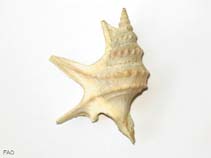Aporrhais pespelecani (Linnaeus, 1758)
Pelican's foot| Native range | All suitable habitat | Point map | Year 2050 |

|
| This map was computer-generated and has not yet been reviewed. |
| Aporrhais pespelecani AquaMaps Data sources: GBIF OBIS |
Классификация / Names народные названия | синонимы | CoL | ITIS | WoRMS
Gastropoda | Littorinimorpha | Aporrhaidae
Environment: milieu / climate zone / пределы глубины / distribution range экология
; пределы глубины 6 - 8 m (ссылка 118694). Temperate; 76°N - 25°N, 31°W - 61°E
Distribution страны | регионы FAO | Ecosystems | места находок | интродукции
Northeast Atlantic, Arctic and the Mediterranean: North and Celtic seas. Temperate to polar.
Length at first maturity / Size / Weight / Возраст
половая зрелость: Lm ? range ? - ? cmCommon length : 5.1 cm SHL самец/пол неопределен; (ссылка 360)
Краткое описание морфология
Life cycle and mating behavior половая зрелость | размножение | нерест | Eggs | Fecundity | Larvae
Основная ссылка
ссылки | координатор | соавторы
Sabelli, B. and H.S. Feinberg (eds.) 1879 Simon and Schuster's Guide to Shells. Simon and Schuster's Inc. New York. 512 pp. (ссылка 360)
Статус Красного Списка МСОП
(ссылка 130435: Version 2025-1)
Статус СИТЕС (ссылка 108899)
CMS (ссылка 116361)
Угроза для людей
Использование человеком
| FishSource |
инструменты
дополнительная информация
состав пищи
потребление пищи
хищники
ресурсы в Интернет
Alien/Invasive Species database | BHL | BOLD Systems | CISTI | DiscoverLife | FAO(Publication : search) | Fishipedia | GenBank (Геном, Нуклеотид) | GloBI | Gomexsi | Google Books | Google Scholar | Google | PubMed | Tree of Life | Wikipedia (Вперёд, поиск) | Zoological Record



